American Craft Council Show in Baltimore, the good stuff


Welcome to this bilingual (Swedish-English) group blog by family members living on both sides of the Atlantic Ocean, "the pond". Our interests range from the scientific to the eclectic, including gourmet food, horses, art and literature, computers, species in nature, history and iron, and photography. Three generations are posting here.


The Swedish Museum of Art (Nationalmuseum) in Stockholm is now closed for a several year long renovation, but we visited it one of the last weekends when it was open and I was in Stockholm. One of the most fun exhibits was the one on functional and industrial design. It was filled with so many items I know so well from my upbringing in Sweden, and some of them have even made it over to the US. Here is a selection, with annotations:

When I grew up we had a Lamino chair at home, covered with gray woolskin, and it was wonderful. I had no idea then that it was a classic bent-wood design. The chair and its footstool is still in my mom's apartment and I sat in it just a month ago.
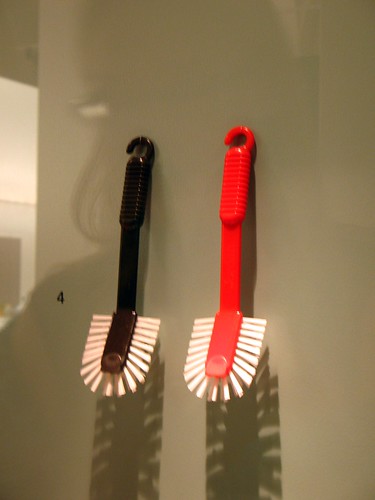
Swedish dishbrushes! Once I went to a summer camp with a girl whose father had the patent on the straight line on the front that you use to scrape off hard pieces from your plates if you turn the brush around. I bet he got a lot of money from all the dishbrushes that have been made in the last many decades.

This kind of very plastic and cheap-looking lamp was common in youth hostels and rented cabins. I think we had one too, orange maybe, and I have a vague memory that it nearly caught on fire once, but I could be wrong. They weren't very good lamps, but popular.
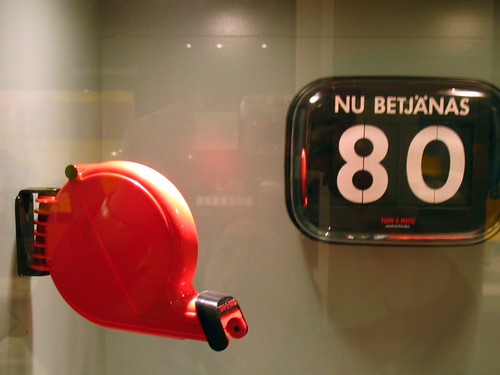
The very practical Swedish queue-system. Used at every postoffice, bank, police station, you name it. I actually like this a lot better than standing in lines.

A classic telephone, of the type that was provided by the phone company. Back then you couldn't buy your phone, it was provided and owned by the phone company. I think this one was made by Ericsson for the state-owned telephone company (which is no more, it is now privatized). These were still in use in the 2000s, but I think they are gone now, since the outlets are different now. Oh all the times I sat and dialed the numbers on the turning dial.... You couldn't hurry it, it took its time.
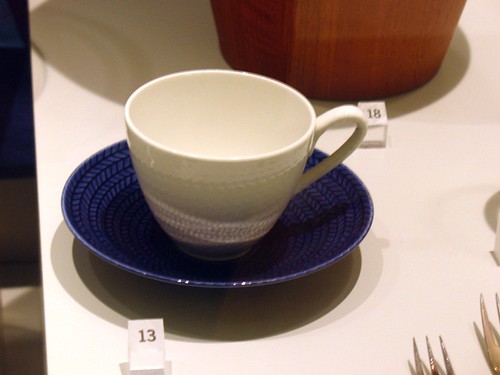
This line of china is one of my favorites, and we had some at home when I grew up. Blå eld means Blue Fire, and my sister collects this brand.
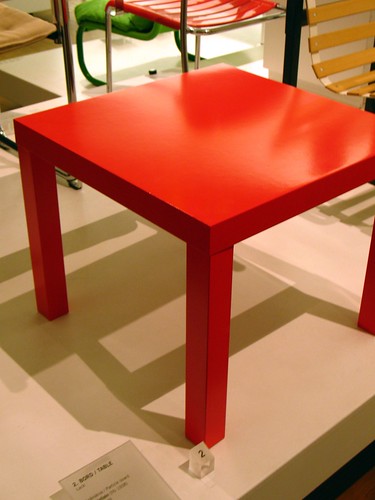
This is probably the most common object in the whole exhibit. IKEA's table LACK, which is still being sold. We have several here at home in the US. IKEA furnished so many homes in Sweden, it saved our budgets and book collections (thanks for Billy!). I didn't realize that the LACK design was over 40 years old by now.

I don't know the year of this collection of dairy containers, maybe late 1980s? Featured here are: regular milk (3% fat), 'middle milk' (1.5% fat), light milk (0.5% fat - too watery for me), mini milk (0% fat or nearly so), 'vispgrädde' heavy cream (40% fat), and 'gräddfil' (sour creme, but runnier, 12% fat). The containers are Tetrapak, paper with plastic on the inside. Oh, the memories.... :)
Posted by
LS
at
10:09 PM
3
comments
![]()
Labels: 1950s, 1960s, 1970s, art, design, family history, food, furniture, industrial design, interior design, kitchen, Sweden, tools
Posted by
LS
at
10:43 AM
0
comments
![]()
Labels: animals, New Jersey, night, photography, train, transportation, winter
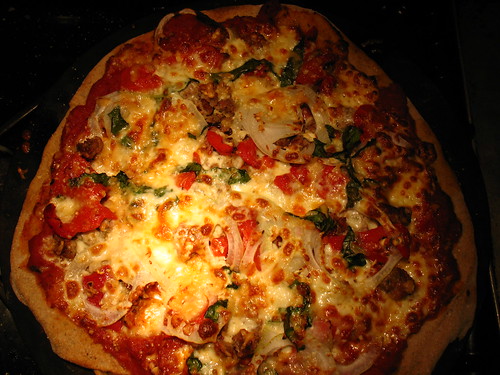
We have a Friday night tradition since the last couple of years - homemade thin-crust pizza. After maybe 100 times of making pizza dough, tomato sauce and toppings, I think we have it down to near perfection now. So, dear readers, as per request from several of you, here are the instructions.
Our dough was initially based on this recipe by Barbara Kingsolver, but we have modified it slightly. Look for the heading for the part of the recipe you need.
TOOLS
As for tools, we use a KitchenAid mixer to mix the dough (optional), a rolling pin (just regular wood), and a ceramic pizza stone (you can use a regular cookie sheet, but a stone makes a big difference if you are going to make pizza often).
Our stone is as large as possible and round, and so light that you can lift it in and out of the oven easily. I wouldn't recommend those superthick real stones. I can see a lot of crushed toes and achy backs from using those in a regular kitchen. Our stone is made of ceramics, very durable, started out as white but is now black (which is normal), and less than 1/2 inch (1 cm thick). It is very easy to lift the stone out of the oven with the pizza on it, so no need to fiddle with wooden paddles or peels and other things you don't really need. Just get a thin stone and use your regular tools to lift the pizza over to a serving plate or serve it on the stone. And of course you can bake bread on the stone of you like too.
A pizza slicer is good, but think about what is below the pizza. Soft aluminum might get scratched, and I don't really know if you can use it directly on the stone (we use heavy-duty scissors to cut our pizza mostly).
The recipe below makes 4 wonderful 16-inch pizzas (30 cm).
PIZZA DOUGH (partly whole-wheat, healthier style)
Time (active): 10 min. Time (waiting): 2-10 hours.
Ingredients:

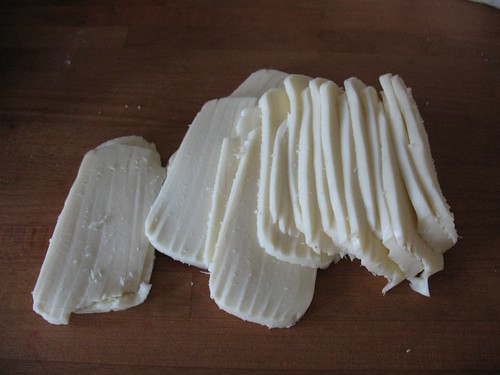

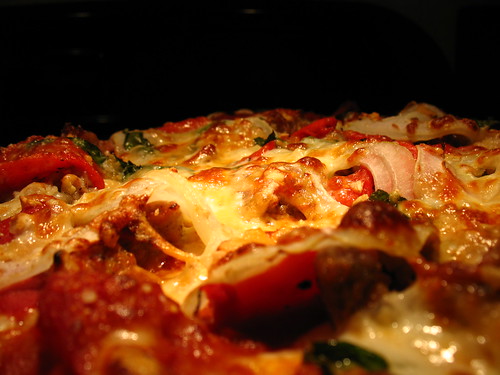
Posted by
LS
at
9:55 AM
2
comments
![]()
Posted by
LS
at
6:20 AM
0
comments
![]()
Labels: morning walk, New Jersey, photo, weather, winter
A few months ago I picked up an old Swedish book given to me by a friend, who I have long forgotten, but it was a book I had wanted to read for a long time: Bruce Chatwin's In Patagonia. I think my copy might be the first edition from 1981 in Swedish. I dug in and started to read, with high expectations, because this was a 'real travel writer'!. As you might know, I mostly read right before I fall asleep, maybe half an hour a day, at the most.
 Bruce Chatwin leaves work and travels to Patagonia, seemingly unplanned, a place he has always wanted to visit. His travel diary is not a diary in the regular sense, more broken pieces and fragments of text from his experiences in Patagonia with inserts of history, commentary, and cultural reflections.
Bruce Chatwin leaves work and travels to Patagonia, seemingly unplanned, a place he has always wanted to visit. His travel diary is not a diary in the regular sense, more broken pieces and fragments of text from his experiences in Patagonia with inserts of history, commentary, and cultural reflections.
And here is the main problem. Bruce stands outside the whole travel experience. He reports like a objective journalist, not a person present in the moment. And he even fails at being objective, because many times you can clearly feel the aversion he has to the people he meets. It is not a boring book, and the text is excellently written, beautiful in fact, but it is not a good book. You don't get a feel for the place, and it is too fragmented.
The detachedness of Bruce Chatwin is disturbing. I can't remember any of the persons he describes in such detail, no stories, no places, no names or characters. No recollection. There is no focus at all. How can that be? It was like nothing as memorable. I know that this is considered one of the best travel books ever written, but I will have to disagree, strongly. So I gave up, 10-20 pages from the end.
A few weeks later I needed a book with me when I had to wait for my daughter at the dentists. I looked in our bookshelf and found "The Old Patagonian Express" by Paul Theroux! I remember buying this book for my husband, but none of us had read it yet. I brought it with me, read a few pages at the dentist, and was hooked. And last night, I finished it. What a difference. What joy. I envy people that haven't read this book, they have such a good read in front of them.
Paul Theroux's book was published a year (1979) after Bruce Chatwin's book and they were friends. The books are like night and day in difference. While Bruce Chatwin talks about Patagonia, he never explains how he got there, and his book has not one structured path in it. Paul Theroux, on the other hand, has a plan, and he loves travel, which for him means to GET TO another place, not BE IN another place. And I think he is right. True travel is the transportation phase, the active movement through places, not being dumped in a place and staying there.
 The way Paul Theroux traveled to Patagonia is the focus, the structure, of the whole book. He gets on the subway and then commuter train in Boston in a snowstorm, and then takes local train after local train down to Mexico, through Central America, along the Andes, through long Argentina, and then eventually ends up on The Old Patagonian Express, the narrowgauge steam train that goes to Esquel. And then the book is over.
The way Paul Theroux traveled to Patagonia is the focus, the structure, of the whole book. He gets on the subway and then commuter train in Boston in a snowstorm, and then takes local train after local train down to Mexico, through Central America, along the Andes, through long Argentina, and then eventually ends up on The Old Patagonian Express, the narrowgauge steam train that goes to Esquel. And then the book is over.
This book is not about Patagonia, this book is about human nature, nature and humans. Culture, politics, some natural history, pestering travel companions, good and bad hotel rooms, dusty old railroad cars, giant steaks in dining cars, delays, landslides, revolts, and rats chewing holes in the ceiling above your bed. It also has great interactions between Paul Theroux and the people he meets, from street urchins in Colombia to impossible Mr Thornberry in Costa Rica and the Argentinians need to be superior while having the right to complain about anything in their own country (and nobody else should).
It is a fantastic story, a meandering travel path through not only North and Latin American geography, but also classic literature (Paul Theroux discusses the books he reads during the trip), and it feels real and human. He is not trying to be some übermensch, not someone that stands above or besides his co-travelers or people he meets. He just is. Now I have to read his other travel books! Wow, what a read! Yes, A+ and five stars of course.
There are a lot of great passages in The Old Patagonian Express, and here is one that I think fits this review pretty well:
Reading alters the appearance of a book. Once it has been read, it never looks the same again, and people leave their individual imprint on a book they have read. One of the pleasures of reading is seeing this alteration on the pages, and the way, by reading it, you have made the book yours.
Posted by
LS
at
10:36 PM
2
comments
![]()
Labels: Andes, book review, books, Central America, history, literature, Mexico, politics, South America, steam, train, travel, USA
Posted by
EH
at
6:55 AM
2
comments
![]()
